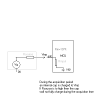I'm using ADC inside CC2430 MCU.
The ADC present the result (= digital voltage) over 2 bytes - ADCH, ADCL.
(ADCL uses only 6 MSB bits, the 2 LSB bits are always read 0).
I chose VREF = 3.3V, and entered to ADC a 1.5V battery.
When i chose 12-bit resolution, the ADC showed 15124.
When i chose 7-bits resolution, the ADC showed 15296
Now when i do
[(15124 / 4) / 2^13] * 3.3V = 1.523V
[(15296 / 4) / 2^13] * 3.3V = 1.54V
( the " / 4 " is because ADCL's 2 LSB bits are always read 0).
I have 2 questions please:
1. Did i calculate the analog input correctly?
2. Is there a minimal analog input, that below it the ADC starts being less accurate? how is it in general?
Thank you for any help.
The ADC present the result (= digital voltage) over 2 bytes - ADCH, ADCL.
(ADCL uses only 6 MSB bits, the 2 LSB bits are always read 0).
I chose VREF = 3.3V, and entered to ADC a 1.5V battery.
When i chose 12-bit resolution, the ADC showed 15124.
When i chose 7-bits resolution, the ADC showed 15296
Now when i do
[(15124 / 4) / 2^13] * 3.3V = 1.523V
[(15296 / 4) / 2^13] * 3.3V = 1.54V
( the " / 4 " is because ADCL's 2 LSB bits are always read 0).
I have 2 questions please:
1. Did i calculate the analog input correctly?
2. Is there a minimal analog input, that below it the ADC starts being less accurate? how is it in general?
Thank you for any help.







